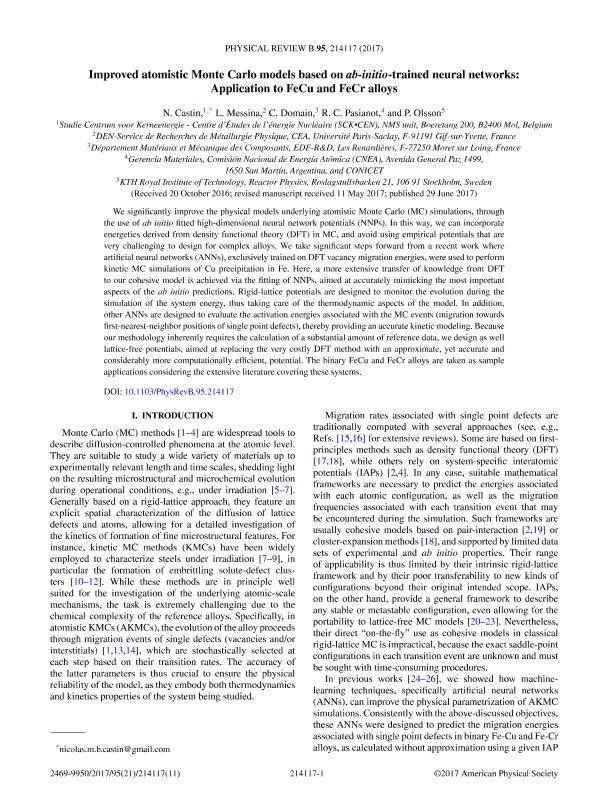Mostrar el registro sencillo del ítem
dc.contributor.author
Castin, N.
dc.contributor.author
Messina, L.
dc.contributor.author
Domain, C.
dc.contributor.author
Pasianot, Roberto Cesar

dc.contributor.author
Olsson, P.
dc.date.available
2019-05-13T18:48:49Z
dc.date.issued
2017-06
dc.identifier.citation
Castin, N.; Messina, L.; Domain, C.; Pasianot, Roberto Cesar; Olsson, P.; Improved atomistic Monte Carlo models based on ab-initio -trained neural networks: Application to FeCu and FeCr alloys; American Physical Society; Physical Review B; 95; 21; 6-2017
dc.identifier.issn
2469-9950
dc.identifier.uri
http://hdl.handle.net/11336/76193
dc.description.abstract
We significantly improve the physical models underlying atomistic Monte Carlo (MC) simulations, through the use of ab initio fitted high-dimensional neural network potentials (NNPs). In this way, we can incorporate energetics derived from density functional theory (DFT) in MC, and avoid using empirical potentials that are very challenging to design for complex alloys. We take significant steps forward from a recent work where artificial neural networks (ANNs), exclusively trained on DFT vacancy migration energies, were used to perform kinetic MC simulations of Cu precipitation in Fe. Here, a more extensive transfer of knowledge from DFT to our cohesive model is achieved via the fitting of NNPs, aimed at accurately mimicking the most important aspects of the ab initio predictions. Rigid-lattice potentials are designed to monitor the evolution during the simulation of the system energy, thus taking care of the thermodynamic aspects of the model. In addition, other ANNs are designed to evaluate the activation energies associated with the MC events (migration towards first-nearest-neighbor positions of single point defects), thereby providing an accurate kinetic modeling. Because our methodology inherently requires the calculation of a substantial amount of reference data, we design as well lattice-free potentials, aimed at replacing the very costly DFT method with an approximate, yet accurate and considerably more computationally efficient, potential. The binary FeCu and FeCr alloys are taken as sample applications considering the extensive literature covering these systems.
dc.format
application/pdf
dc.language.iso
eng
dc.publisher
American Physical Society
dc.rights
info:eu-repo/semantics/openAccess
dc.rights.uri
https://creativecommons.org/licenses/by-nc-sa/2.5/ar/
dc.subject
Atomistic Montecarlo
dc.subject
Ab-Initio
dc.subject
Neural Networks
dc.subject.classification
Astronomía

dc.subject.classification
Ciencias Físicas

dc.subject.classification
CIENCIAS NATURALES Y EXACTAS

dc.title
Improved atomistic Monte Carlo models based on ab-initio -trained neural networks: Application to FeCu and FeCr alloys
dc.type
info:eu-repo/semantics/article
dc.type
info:ar-repo/semantics/artículo
dc.type
info:eu-repo/semantics/publishedVersion
dc.date.updated
2019-05-13T16:41:44Z
dc.identifier.eissn
2469-9969
dc.journal.volume
95
dc.journal.number
21
dc.journal.pais
Estados Unidos

dc.journal.ciudad
College Park
dc.description.fil
Fil: Castin, N.. Centre d’Études de l’énergie Nucléaire; Bélgica
dc.description.fil
Fil: Messina, L.. Universite de Paris; Francia
dc.description.fil
Fil: Domain, C.. Département Matériaux et Mécanique des Composants; Francia
dc.description.fil
Fil: Pasianot, Roberto Cesar. Consejo Nacional de Investigaciones Científicas y Técnicas; Argentina. Comisión Nacional de Energía Atómica; Argentina
dc.description.fil
Fil: Olsson, P.. KTH Royal Institute of Technology; Suecia
dc.journal.title
Physical Review B
dc.relation.alternativeid
info:eu-repo/semantics/altIdentifier/url/https://journals.aps.org/prb/abstract/10.1103/PhysRevB.95.214117
dc.relation.alternativeid
info:eu-repo/semantics/altIdentifier/doi/https://dx.doi.org/10.1103/PhysRevB.95.214117
Archivos asociados
